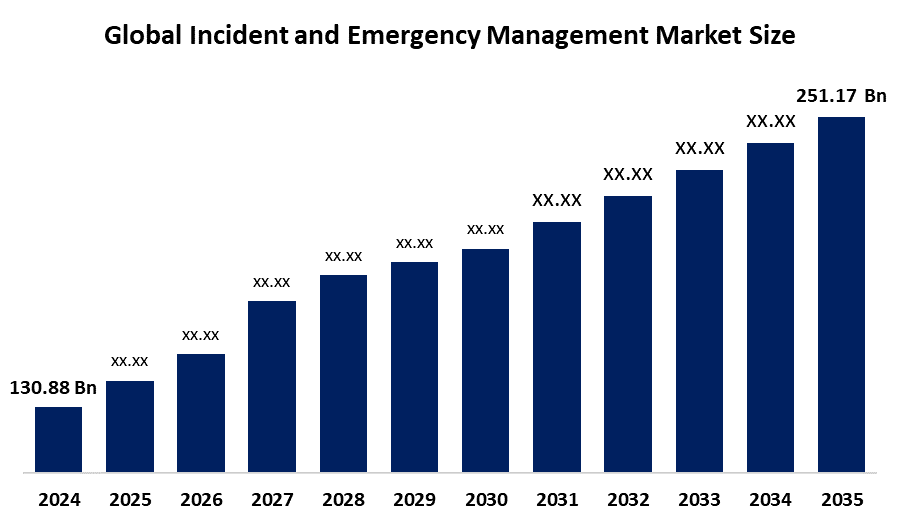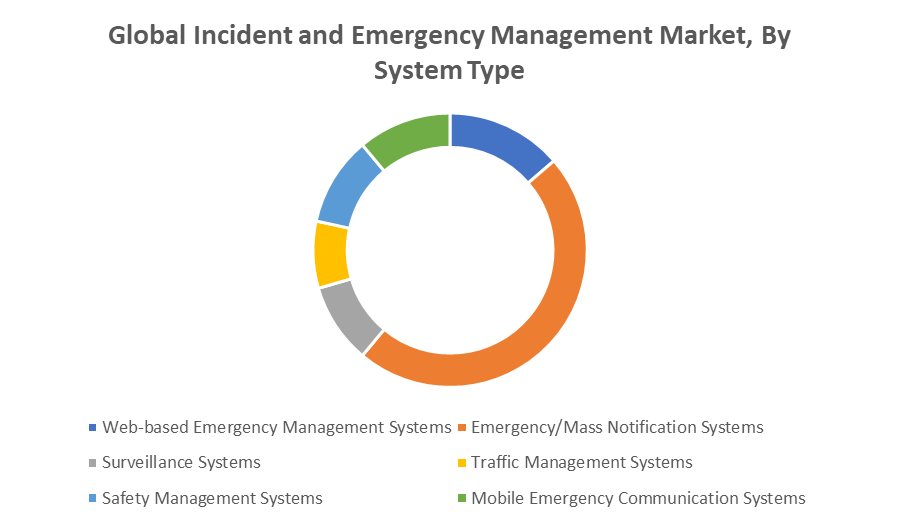Global Incident and Emergency Management Market Insights Forecasts to 2035
- The Global Incident and Emergency Management Market Size Was Estimated at USD 130.88 Billion in 2024
- The Market Size is Expected to Grow at a CAGR of around 6.11% from 2025 to 2035
- The Worldwide Incident and Emergency Management Market Size is Expected to Reach USD 251.17 Billion by 2035
- Asia Pacific is expected to grow the fastest during the forecast period.

Incident and Emergency Management Market
The FGlobal Incident and Emergency Management Market Size involves solutions and services designed to prepare for, respond to, and recover from emergencies such as natural disasters, cyber-attacks, and public safety threats. It includes software for incident reporting, emergency communication, risk assessment, and resource management. Governments worldwide actively promote this market through initiatives aimed at enhancing national security and disaster resilience, such as the U.S. Federal Emergency Management Agency (FEMA) programs and the European Union’s Civil Protection Mechanism. These efforts drive demand for integrated technologies that improve coordination among emergency responders, reduce response times, and minimize damage. The market is growing rapidly due to increasing natural disasters, rising urbanization, and heightened focus on homeland security, with advancements in AI, IoT, and cloud computing enabling smarter emergency management systems. Overall, this sector plays a crucial role in safeguarding communities and infrastructure globally.
Attractive Opportunities in the Incident and Emergency Management Market
- The integration of AI, machine learning, and the Internet of Things enables smarter, faster incident detection and response. These technologies improve real-time data analysis, predictive capabilities, and automation, creating significant opportunities for technology providers and service vendors to offer innovative emergency management solutions.
- Rapid urbanization and industrial growth in developing countries increase vulnerability to natural disasters and emergencies. This creates new markets for advanced incident and emergency management solutions, supported by growing government investments in infrastructure development and smart city initiatives.
- With rising cyber threats and attacks, there is increasing need for specialized cybersecurity incident management systems. This opens up opportunities for companies to develop tools focused on protecting critical infrastructure, data, and emergency communication networks from cyberattacks.
Global Incident and Emergency Management Market Dynamics
DRIVER: Rising urbanization and industrialization expose more people
Key growth factors for the Incident and emergency management market include increasing frequency and severity of natural disasters like hurricanes and wildfires, which drive demand for advanced emergency solutions. Rising urbanization and industrialization expose more people and assets to risks, necessitating better preparedness. Government investments and regulatory mandates for public safety boost adoption of emergency management technologies. Technological advancements such as AI, IoT, and cloud computing enhance real-time data analysis and communication, improving response efficiency. Additionally, growing awareness about disaster preparedness among organizations and communities fuels market expansion, making integrated, automated incident management systems essential for mitigating risks worldwide.
RESTRAINT: Fragmented regulatory frameworks across countries
Restraining factors for the incident and emergency management market include high implementation and maintenance costs of advanced technologies, which can be prohibitive for smaller organizations and developing regions. Lack of skilled personnel to operate sophisticated systems limits adoption. Data privacy and security concerns, especially when integrating cloud-based and IoT solutions, pose challenges. Additionally, fragmented regulatory frameworks across countries create compliance difficulties for global deployments. Resistance to change within traditional emergency response agencies can slow technology adoption. Finally, inconsistent funding and budget constraints, particularly in less developed areas, hinder large-scale investments, restricting overall market growth despite rising demand.
OPPORTUNITY: Growing adoption of emerging technologies like artificial intelligence
Growing adoption of emerging technologies like artificial intelligence, machine learning, and the Internet of Things enables smarter, faster incident detection and response. Integration of big data analytics offers enhanced predictive capabilities, helping authorities prepare proactively. Expansion in developing regions with rising urban populations creates new markets for emergency management solutions. Moreover, rising cyber threats open avenues for cybersecurity-focused incident management tools. Governments worldwide continue to invest in smart city initiatives and critical infrastructure protection, boosting demand. Partnerships between technology providers and public agencies can foster innovation. Additionally, increasing awareness and training programs present opportunities for service providers to offer comprehensive emergency preparedness and management solutions.
CHALLENGES: Hindering seamless communication during emergencies
Challenges in the incident and emergency management market include interoperability issues among diverse systems and agencies, hindering seamless communication during emergencies. Limited infrastructure in developing regions restricts technology deployment. Data security concerns and potential cyberattacks on emergency systems pose significant risks. Additionally, the complexity of integrating new technologies with legacy systems can delay implementation. Budget constraints and inconsistent funding, especially in smaller municipalities, limit access to advanced solutions. Finally, resistance to change and lack of trained personnel reduce the effectiveness of emergency management initiatives.
Global Incident and Emergency Management Market Ecosystem Analysis
The global incident and emergency management market ecosystem includes technology providers delivering software, communication tools, and IoT devices for real-time monitoring. Emergency response agencies, such as government bodies and first responders, use these solutions for coordinated action. System integrators customize deployments, while cloud providers offer scalable data storage and processing. Data analytics firms supply predictive insights, and regulatory authorities ensure compliance and interoperability. Collaboration among these stakeholders fosters innovation, improves emergency response efficiency, and enhances global disaster resilience.
Based on the component, the solutions segment accounted for the major revenue share over the forecast period
The solutions segment accounted for the major revenue share over the forecast period. This is due to increasing demand for comprehensive incident and emergency management software that enables real-time monitoring, communication, and coordination among responders. Solutions such as incident reporting, risk assessment, and emergency communication platforms are critical for effective disaster management, driving higher adoption. Additionally, advancements in technology and integration capabilities make these solutions essential for organizations and governments, contributing significantly to market revenue growth.
Based on the system type, the emergency/mass notification systems segment held the leading revenue share during the forecast period

The emergency/mass notification systems segment held the leading revenue share during the forecast period. This dominance is driven by the critical need for rapid, wide-reaching communication during emergencies to alert and guide the public and responders. These systems enable timely dissemination of information through multiple channels such as SMS, emails, sirens, and mobile apps, enhancing situational awareness and safety. Growing investments by governments and organizations to improve public safety infrastructure further boost the adoption and revenue of this segment.
North America is anticipated to hold the largest market share of the incident and emergency management market during the forecast period
North America is anticipated to hold the largest market share of the incident and emergency management market during the forecast period. This is attributed to the region’s advanced infrastructure, strong government initiatives, and significant investments in public safety and disaster management technologies. The presence of major technology providers, stringent regulatory frameworks, and high awareness about emergency preparedness also drive market growth. Additionally, frequent natural disasters and increasing cybersecurity threats in North America further boost demand for sophisticated incident and emergency management solutions.
Asia Pacific is expected to grow at the fastest CAGR in the incident and emergency management market during the forecast period
Asia Pacific is expected to grow at the fastest CAGR in the incident and emergency management market during the forecast period. Rapid urbanization, increasing industrialization, and rising vulnerability to natural disasters like floods and earthquakes drive demand for advanced emergency management solutions. Growing government investments in infrastructure development, smart city projects, and disaster resilience initiatives further fuel market growth. Additionally, improving digital connectivity and adoption of technologies such as AI and IoT in the region contribute to the accelerated expansion of the market.
Recent Development
- In November 2024, Motorola Solutions acquired UK-based 3tc Software to strengthen its cloud-based control room and Computer-Aided Dispatch (CAD) solutions. This move enhances real-time emergency response and situational awareness, enabling faster, more coordinated actions during incidents. It reflects the broader industry trend toward integrating advanced cloud technologies to improve emergency management efficiency and effectiveness.
Key Market Players
KEY PLAYERS IN THE INCIDENT AND EMERGENCY MANAGEMENT MARKET INCLUDE
- Motorola Solutions
- Honeywell International
- Siemens AG
- IBM Corporation
- Hexagon AB
- NEC Corporation
- Everbridge Inc.
- Esri
- Genasys Inc.
- RapidSOS
- Others
Market Segment
This study forecasts revenue at global, regional, and country levels from 2020 to 2035. Spherical Insights has segmented the incident and emergency management market based on the below-mentioned segments:
Global Incident and Emergency Management Market, By Component
- Solutions
- Services
- Communication Systems
Global Incident and Emergency Management Market, By System Type
- Web-based Emergency Management Systems
- Emergency/Mass Notification Systems
- Surveillance Systems
- Traffic Management Systems
- Safety Management Systems
- Mobile Emergency Communication Systems
Global Incident and Emergency Management Market, By Regional Analysis
- North America
- Europe
- Germany
- UK
- France
- Italy
- Spain
- Russia
- Rest of Europe
- Asia Pacific
- China
- Japan
- India
- South Korea
- Australia
- Rest of Asia Pacific
- South America
- Brazil
- Argentina
- Rest of South America
- Middle East & Africa
- UAE
- Saudi Arabia
- Qatar
- South Africa
- Rest of the Middle East & Africa





